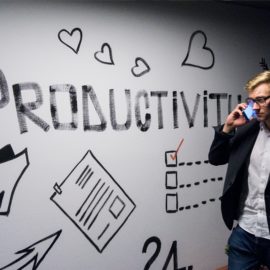

This article is an excerpt from the Shortform book guide to "The Leadership Challenge" by James M. Kouzes and Barry Z. Posner. Shortform has the world's best summaries and analyses of books you should be reading.
Like this article? Sign up for a free trial here .
How does employees’ self-confidence affect performance? What can you, as a leader, do to boost your employees’ confidence in their roles?
Most leaders realize that competence is important, but confidence is just as crucial. In fact, studies have shown that self-confidence is an even stronger predictor of performance than skill level or training.
To boost your employees’ confidence in their roles, follow these practices.
How to Strengthen Staff’s Confidence
To strengthen your employees’ confidence, ensure that everyone has the knowledge, skills, and resources to do their jobs. To this end:
- Challenge their skills.
- Share information.
- Educate about key company metrics.
- Foster a growth mindset.
- Coach.
Challenge Their Skills
People do their best work when their task is slightly more challenging than their skill level. That’s when they feel neither overwhelmed nor bored. It’s also when they report feeling “in the flow,” which is the sense that they’re performing expertly even if the challenge is difficult. When people are performing at this level, they’re gaining competence by stretching their skills and confidence by seeing their progress, and they’re most satisfied with their work.
As a leader, aim to provide the conditions that make flow possible. This means periodically assessing your team members’ skill levels and the difficulties of the challenges they face, to make sure that their skills and challenges don’t become unbalanced.
(Shortform note: For more about what flow is, how it affects happiness, and how to cultivate it, read our guide to Flow by Mihaly Csikszentmihalyi.)
Share Information
Your team won’t be able to make decisions without adequate information and training, and they’ll be hesitant to exercise their judgment for fear of making mistakes. Therefore, when guiding your team to become more self-sufficient, increase your investment in training and development.
Employees value skills training highly and are more likely to stick with a company that provides it. In fact, studies show that 40% of employees who report little or no skills training leave their positions within the first year, citing the lack of training as the reason.
Another reason to invest in training and development is that in today’s world, industries and technologies change very quickly, and it benefits you and your organization to have team members who can adapt to changing needs. An adaptable and flexible workforce will lessen the need for you to hire from the outside or lose market opportunities.
An example of a manager who successfully encouraged his team members to learn and share information was Jeff Allison of PW Enterprises. When a reorganization required him to be off-site and away from his team for much of the workweek, he knew he’d have to empower them to solve problems without his oversight. He spent a month walking them through a few dozen recent problems he’d faced, making sure they had the information and skills needed to resolve similar situations. Additionally, he gave each employee a hypothetical problem, challenged them to solve it, and had them each present their process to the rest of the team. This allowed them to not only learn from him but also from each other, which accelerated the learning process.
Educate About Key Company Metrics
Make sure your team members understand the fundamentals of how your organization works, so they’re able to make critical decisions about key issues when needed. If your team members don’t understand how your organization works, they won’t have a sense of ownership and can’t step up into leadership roles. Educate them about important elements of your organization, including its:
- Most important customers, clients, suppliers, and stakeholders
- Goals and how you measure progress toward them
- Track record of performance
- Pipeline of products, services, or ideas
Foster a Growth Mindset
When a person has a growth mindset as opposed to a fixed mindset, which we discussed under Guideline 6r, they’re more likely to develop confidence and competence. Research shows that people who are told that decision-making is a skill that can improve through practice (a characteristic of growth mindsets) have more confidence and better results than people who are told that decision-making is a reflection of innate intelligence (a characteristic of fixed mindsets).
When people believe in themselves in this way, messages of self-confidence can mold their thinking. Research shows that people are also susceptible to messages regarding whether or not they have the ability to effect change in other people (in addition to change in themselves), and their confidence is shaped by those messages. Studies show that groups who are told they can influence their colleagues’ decisions are more confident—and also perform better—than groups who are told that they’re unlikely to influence their colleagues’ behavior.
Coach
Coaching is the process of giving constructive feedback, asking probing questions, and actively teaching important concepts. Coaching is different from training; in fact, job training must be accompanied by coaching for it to improve job performance. In a three-year study, employees who had ongoing coaching conversations with their managers after receiving training were four times as likely to be recognized as “high improvement learners” than were employees who received training but no coaching afterward.
As a coach, your role is to help your team member to achieve her goals not by showing her what to do, but by showing her how to figure it out for herself. When you help another person grow, that person tends to reciprocate by helping you grow—by helping you achieve your organizational goals. This is why consistently, employees who receive coaching report feeling strongly supported by their company and committed to the company in turn.
One of the most effective ways to coach someone is to ask lots of questions, which:
- Allows the other person to think about a situation from their perspective
- Indicates trust in the other person’s opinions and abilities
- Creates buy-in for whatever decision you ultimately reach, since you involved the other person
Case Study: Sara Balducci at Management Services Company
Sara Balducci demonstrated how to successfully empower a team by encouraging joint efforts, cultivating common goals, and fostering self-determination and competence when her division of an international management services provider doubled in headcount. With the larger number of employees, Sara suddenly found herself leading a department full of people who didn’t know each other or how other people’s jobs contributed to the whole picture. Her team members were confused and demoralized.
To foster interconnectedness throughout the division, she split the division’s tasks into segments and assigned team members to different crews, based on their areas of expertise, to address the task segments. For example, some addressed international customers, some worked on shipping concerns, and some managed customer refunds. By dividing the larger team into smaller teams, each of which could focus on a single goal, she created a feeling within each small team of a common goal, and between the teams, of a larger common goal to which each crew could clearly see they contributed.

———End of Preview———
Like what you just read? Read the rest of the world's best book summary and analysis of James M. Kouzes and Barry Z. Posner's "The Leadership Challenge" at Shortform .
Here's what you'll find in our full The Leadership Challenge summary :
- A field guide for becoming the kind of leader that other people want to follow
- The five principles of leadership and their associated guidelines
- Why before you can lead others, you must have a clear understanding of yourself






